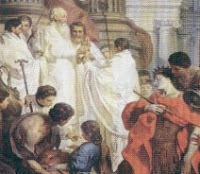
The teachings of the Catholic Church are said to be truths in the supernatural level. It cannot be studied the way Zoology or Physics are studied. Natural things can be studied by man’s natural abilities. It is impossible for man’s natural ability to study supernatural truths.
The way to study supernatural truths is for the natural man to rise up from the natural sphere to the supernatural sphere. And there the soul will effortless receive the truths of the Catholic Faith. These Catholic truths are given to the soul together with the graces and accompanying theological virtues.
In the seminary we must not teach the truths of the Catholic Faith. We teach seminarians how to rise up from the natural level to the supernatural level where graces with its accompanying theological virtues of Faith, Hope and Charity are received from God. These supernatural truths are taught by God by infusion and not learned from teachers in the seminary…….though God could use a holy professor as an instrument to infuse these truths. But it will be evident that it was God, and not the professor, who had given the knowledge.
The seminarians had been studying their theology in the wrong way. While remaining in the natural level they try to study a subject that is over and above their heads in the supernatural level. So they learn nothing, understand nothing and end up without wisdom which is needed to fully imbibe the truths.
Ignorance of the theology of grace is the root of this problem. To know the truths of Christ they must first live fully the life of repentance (which unfortunately many do not know how) after which they would receive graces with its accompanying theological virtues of Faith, Hope and Charity. It is in receiving Faith that they receive the infused knowledge of the teachings of Christ as proposed by the Church.
Many seminarians enter the seminary without knowing that they have lost the grace they have received at Baptism and do not have the capability to know any Catholic Truth. This is the reason Pope Benedict declared the Year of the Priest whose theme is Faithfulness of Christ. He was encouraging Priest to reach at least Faith and not even Hope and Charity. And reminded all that ‘the gift of divine grace precedes every possible human response and pastoral accomplishment..’ He was saying that you cannot become a priest or even begin your seminary training without knowing and putting into practice the theology of grace. And the problem is that most seminarians do not even know if they are in the state of grace or not when they begin their seminary training.
The Holy Father repeats: You must have “a clear and unmistaken judgment about the absolute primacy of divine grace, recalling what St.Thomas Aquinas wrote…” In short, we cannot learn the simplest Catholic truth without grace. And yet we have no idea if we have grace or not.
Then the Pope reminds us of his “Deus Caritas Est” actually saying if you cannot reach the theological virtue of Charity at least reach Faith. Then he encourages all to help the poor priest ‘to reach spiritual perfection’…..that is Charity, i.e. being perfect as the heavenly Father is perfect.
The state of the seminaries is this: we have seminarians who were baptized when they were babies and who during their lives in the world have lost that sacramental grace, probably without realizing it. Then they enter the seminary not knowing they do not have the grace to learn the supernatural truths. Presuming they are in the state of grace they study theology without knowing and understanding anything. The result priestly souls who are total slaves of their fallen nature.
Let us see how they did it in the early times when we could find holy priest in every corner. The seminarians should be taught to use their natural abilities to learn how to rise from the natural to the supernatural level. They must, then, know that entering the supernatural level is a work of grace a completely free act of God. When God raises them up to the supernatural level, God will give them the theological virtue of Faith with a little dosage of Hope and Charity that will enable them to effortless know the teachings of the Catholic Church. They will not need the entire seminary in the process. They only need, as Christ said, to enter their room and lock the door.










